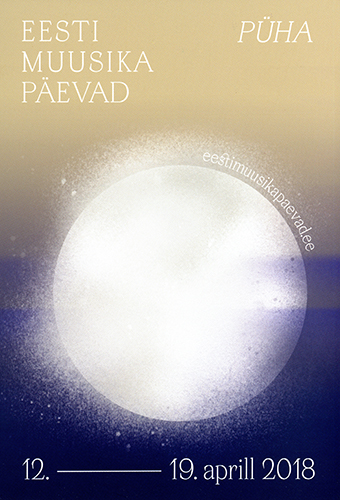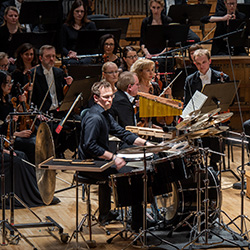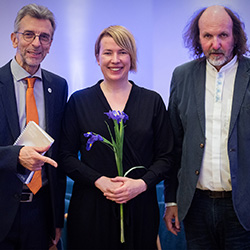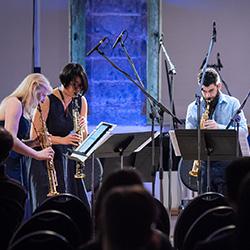 A few days ago i returned from spending a week in the city of Tallinn, experiencing most of this year’s Eesti Muusika Päevad, the Estonian Music Days, the country’s most important festival devoted to contemporary music. In previous years i’ve commented on the perception that what one hears during EMD often seems remarkably removed from the conventions and traditions that we associate with new music in western Europe, and in tandem with this, that the development of Estonian contemporary music can appear to have taken place – and, to an extent, continue to be exercised – in a kind of hermetically-sealed bubble. As my understanding and appreciation of this music has deepened, i’ve come to realise there’s both truth and falsehood in these perceptions, but to say that the situation is a complex one – due to a tangled mixture of political, geographical and cultural elements – is to put it extremely mildly.
A few days ago i returned from spending a week in the city of Tallinn, experiencing most of this year’s Eesti Muusika Päevad, the Estonian Music Days, the country’s most important festival devoted to contemporary music. In previous years i’ve commented on the perception that what one hears during EMD often seems remarkably removed from the conventions and traditions that we associate with new music in western Europe, and in tandem with this, that the development of Estonian contemporary music can appear to have taken place – and, to an extent, continue to be exercised – in a kind of hermetically-sealed bubble. As my understanding and appreciation of this music has deepened, i’ve come to realise there’s both truth and falsehood in these perceptions, but to say that the situation is a complex one – due to a tangled mixture of political, geographical and cultural elements – is to put it extremely mildly.
For the last three years the artistic directors of EMD, composers Helena Tulve and Timo Steiner, have chosen an annual theme for the festival, which is deliberately pithy and allusive in order not to be too prescriptive and to allow composers and audiences the widest possible scope for interpretation (to date: ‘abundance’ in 2015, ‘green sound?’ in 2016 and ‘through dimness’ last year). For 2018 the theme was püha, the Estonian word for ‘sacred’ or ‘holy’, and this point of reference could be felt as a constant through pretty much every concert, though continually provoking a need for reassessment of what that word means and implies, and from much more than just a musical perspective.
Looking first at the instrumental works performed during the festival, arguably the most hard-hitting music came in the Friday evening orchestral concert that took place in Tallinn’s lavish Estonia Concert Hall. Given by the Estonian National Symphony Orchestra conducted by Risto Joost, it was dominated by a pair of large-scale works by two of Estonia’s most esteemed composers, Erkki-Sven Tüür‘s Symphony No. 4 ‘Magma’ – a work composed in 2002 that’s as much a percussion concerto as a symphony (originally written for Evelyn Glennie) – and Toivo Tulev‘s Kolm sümfooniat (Three symphonies), receiving its world première. Anyone even remotely familiar with Tüür’s music will be aware of the composer’s preoccupation with creating, harnessing and unleashing energy, and while his more recent work – such as the epic Ninth Symphony about which i wrote in January – has tended to channel this through nuanced narrative structures, in the case of the ‘Magma’ symphony, as the name implies, it’s much more raw and elemental. Indeed, while it would be easy for a work as full-throttle as this to just crash and burn, one almost imagined Risto Joost’s conducting approach had been designed to be as hands-off as possible, recognising that the forces confronting him were too massive and unwieldy to yield to any form of control. In this respect, percussionist Heigo Rosin, although a soloist – the extent of his kitchen department stretching right across the full width of the front of the stage – acted primarily as a kind of mouthpiece for the full orchestra, a focal point in the midst of a vast maelstrom.
 If Tüür’s aim, in part at least, was to overwhelm with this work, the performance certainly lived up to that, from the queasy opening accents that sound as if the world were being ripped open and everything had been sent flying in slow motion, through the work’s subsequent episodes of turbulence and rhythmic momentum, their effect an accumulative one. The cadenza for drum kit (a throwback to Tüür’s origins in a rock band) was a rare moment of respite in such thunderous clamour, though Rosin’s interpretation of some of the score’s more soft and subtle moments were executed with charming intimacy, the most striking example being when a mark tree and shell chimes were ‘played’ by nothing more than a gentle puff of air blown at them. Moments such as these only made the dynamic range of the symphony feel more enormous, and while there was something impersonal about the vast volcanic scale of the work, the sense of awe that it projected – which one might interpret as the sacred power of nature – was impossible to deny. A work of rare power; if anyone had been rash enough to listen to this performance standing up, they would have found themselves being repeatedly blown off their feet. Incidentally, it’s worth mentioning that Heigo Rosin performed his entire solo part from memory, an astounding feat.
If Tüür’s aim, in part at least, was to overwhelm with this work, the performance certainly lived up to that, from the queasy opening accents that sound as if the world were being ripped open and everything had been sent flying in slow motion, through the work’s subsequent episodes of turbulence and rhythmic momentum, their effect an accumulative one. The cadenza for drum kit (a throwback to Tüür’s origins in a rock band) was a rare moment of respite in such thunderous clamour, though Rosin’s interpretation of some of the score’s more soft and subtle moments were executed with charming intimacy, the most striking example being when a mark tree and shell chimes were ‘played’ by nothing more than a gentle puff of air blown at them. Moments such as these only made the dynamic range of the symphony feel more enormous, and while there was something impersonal about the vast volcanic scale of the work, the sense of awe that it projected – which one might interpret as the sacred power of nature – was impossible to deny. A work of rare power; if anyone had been rash enough to listen to this performance standing up, they would have found themselves being repeatedly blown off their feet. Incidentally, it’s worth mentioning that Heigo Rosin performed his entire solo part from memory, an astounding feat.
For the last two years it’s been a new tradition at this concert to award the Au-tasu composition prize – given to the Estonian composer judged to have composed the best new work premièred within the last 12 months, Liisa Hirsch and Toivo Tulev being the first two recipients – which on this occasion went to Erkki-Sven Tüür for his piccolo concerto Solastalgia, premièred last December in Amsterdam.
i’m still getting to know Toivo Tulev‘s music, but what i’ve encountered thus far suggests a composer whose mode of expression is a polarised one, moving between extremes of intensity without really exploring or even lingering in the regions in between. In the case of Kolm sümfooniat, this was hard to reconcile due to the description Tulev provided for the piece, which is not only personal but positively tender. The work is inspired by, and dedicated to, three women who have been important to Tulev personally and creatively: his “tiny grandmother” Elisabeth Oksermann (nicknamed ‘Thumbelina’), Canadian artist Agnes Martin, and Eleanor Coffey, a friend of the composer from New Hampshire. The first and last movements, titled ‘Prologos’ and ‘Logos’, are to Oksermann and Coffey respectively, while the central movement – the actual ‘Three Symphonies’ of the overall title, named White Flower, Falling Blue and With My Back to the World – is to Martin.
 However, discrete structural boundaries and/or characterisations were hard to discern in Kolm sümfooniat, largely due to the wildly oscillating behaviour of Tulev’s material. This was a problem as it made navigating through the work very difficult. Yet the unpredictable, not to say erratic shifts that typify the work were hugely stimulating and, on occasions, even intimidating, leaving one regularly wondering from where so much heft had suddenly appeared. Considering the trio of homages Tulev was seeking to make – not, it’s worth noting, intended to be portraits – i can’t help wondering whether Tulev’s colours throughout were a bit too vivid and his polarised approach too muscular for their own good. As a consequence the work emphasised the monumental and mighty at the expensive of the miniscule and gentle (which, quite apart from the others, seemed ill-fitted to an homage to Agnes Martin), and despite melody permeating everything in the final movement, plus the addition of a soprano (Helen Lepalaan) singing Catherine Winkworth’s translation of ‘Wachet auf’, i felt brow-beaten and exhausted by the time we arrived at the work’s colossal closing quasi-chorale.
However, discrete structural boundaries and/or characterisations were hard to discern in Kolm sümfooniat, largely due to the wildly oscillating behaviour of Tulev’s material. This was a problem as it made navigating through the work very difficult. Yet the unpredictable, not to say erratic shifts that typify the work were hugely stimulating and, on occasions, even intimidating, leaving one regularly wondering from where so much heft had suddenly appeared. Considering the trio of homages Tulev was seeking to make – not, it’s worth noting, intended to be portraits – i can’t help wondering whether Tulev’s colours throughout were a bit too vivid and his polarised approach too muscular for their own good. As a consequence the work emphasised the monumental and mighty at the expensive of the miniscule and gentle (which, quite apart from the others, seemed ill-fitted to an homage to Agnes Martin), and despite melody permeating everything in the final movement, plus the addition of a soprano (Helen Lepalaan) singing Catherine Winkworth’s translation of ‘Wachet auf’, i felt brow-beaten and exhausted by the time we arrived at the work’s colossal closing quasi-chorale.
 Starting the concert was a short work that, in hindsight, inhabited a soundworld light years away from these symphonies. Inspired by both the simplicity and complexity of the human mind, and seeking to tap into the “non-linear thinking before maps, the clock and the printing press”, it would be more accurate to describe Age Veeroos‘ new work Skein of Thought as a stream rather than an evolution or development of ideas. At first sounding like a strange machine twitching into life, there was something engaging about its overall vagueness – the product of not allowing any ideas to take hold, continually swept away by new ones – though this was frustrating when something really interesting came along (such as an idea involving clarinet multiphonics and high strings). There was something undeniably admirable about such a stubborn, aloof approach to musical material, though judging by the lukewarm applause Skein of Thought received, i don’t think i was the only person whom it left feeling rather empty.
Starting the concert was a short work that, in hindsight, inhabited a soundworld light years away from these symphonies. Inspired by both the simplicity and complexity of the human mind, and seeking to tap into the “non-linear thinking before maps, the clock and the printing press”, it would be more accurate to describe Age Veeroos‘ new work Skein of Thought as a stream rather than an evolution or development of ideas. At first sounding like a strange machine twitching into life, there was something engaging about its overall vagueness – the product of not allowing any ideas to take hold, continually swept away by new ones – though this was frustrating when something really interesting came along (such as an idea involving clarinet multiphonics and high strings). There was something undeniably admirable about such a stubborn, aloof approach to musical material, though judging by the lukewarm applause Skein of Thought received, i don’t think i was the only person whom it left feeling rather empty.
 Not all of the instrumental music performed during EMD proved to be so provocative or challenging, in some cases despite their very obvious best efforts. An entire concert was given over to the music of Iranian composer Arash Yazdani, presented as part of his doctoral studies at the Estonian Academy of Music and Theatre. Yazdani’s work was new to me, and from this lengthy introduction it was abundantly clear that he is seeking to make assorted sonic phenomena the basis for his music, in order to create “a unique hearing experience”. What wasn’t abundantly clear was Yazdani’s understanding of how to shape these phenomena into interesting musical forms. Sho’ebadeH, a moderately theatrical work for three percussionists wielding flexatones and slide whistles, was at least entertaining, its ‘tutti’ passages creating remarkable walls of sound from the manic busyness of the players’ actions, behaviourally identical but individually unique. The remaining four works in the concert were far more problematic, and weren’t aided by Yazdani’s fondness for pretentious and/or contentious programme notes (though considering this was part of his academic output, perhaps one should make allowances). Demodulation explored a litany of sustained blurted pitches gradually building and rising to ear-splitting altitude; there were brief windows into something lyrical that made for an interesting contrast, but it was impossible to connect or interpret anything we were hearing with Yazdani’s stated aims (that listening is an equivalent of demodulation, which it isn’t). Likewise, in Stationarity, on temporal motions for two percussionists Yazdani sought to explore “different and shifting tempi … that individually could be perceived as separate time domains”. They could indeed, but they didn’t, forming a simple duet of cross-rhythms that throughout felt fundamentally connected. This would hardly have mattered if the piece hadn’t been so relentlessly tedious and monotonous, less like a deliberate composition than a science experiment with the resultant data converted into rhythms. There was much more to enjoy in his saxophone quartet Stromateis: …Emergence…, an essentially homogeneous texture comprised of near unisons and close imitation; it again suffered from Yazdani’s inability to be concise with his ideas, flogging them to death, but the altissimo fortiss(iss)imo conclusion was genuinely fascinating, so extreme that the pitches practically cancelled out to leave weird sound artefacts. Dimension II, Destruction for large ensemble felt worrying similar to this in both aesthetic and approach, again exploiting the effect of close pitch collisions and their consequences, within a dull soundscape exhibiting little beyond the most basic notions of drama. Overall, this was a profoundly frustrating and disappointing concert, in which the music seemed reliant on shock tactics – thereby suffering badly from the law of diminishing returns – and superficial concerns at the expense of almost everything else, with little coherent sense of either structure or timing.
Not all of the instrumental music performed during EMD proved to be so provocative or challenging, in some cases despite their very obvious best efforts. An entire concert was given over to the music of Iranian composer Arash Yazdani, presented as part of his doctoral studies at the Estonian Academy of Music and Theatre. Yazdani’s work was new to me, and from this lengthy introduction it was abundantly clear that he is seeking to make assorted sonic phenomena the basis for his music, in order to create “a unique hearing experience”. What wasn’t abundantly clear was Yazdani’s understanding of how to shape these phenomena into interesting musical forms. Sho’ebadeH, a moderately theatrical work for three percussionists wielding flexatones and slide whistles, was at least entertaining, its ‘tutti’ passages creating remarkable walls of sound from the manic busyness of the players’ actions, behaviourally identical but individually unique. The remaining four works in the concert were far more problematic, and weren’t aided by Yazdani’s fondness for pretentious and/or contentious programme notes (though considering this was part of his academic output, perhaps one should make allowances). Demodulation explored a litany of sustained blurted pitches gradually building and rising to ear-splitting altitude; there were brief windows into something lyrical that made for an interesting contrast, but it was impossible to connect or interpret anything we were hearing with Yazdani’s stated aims (that listening is an equivalent of demodulation, which it isn’t). Likewise, in Stationarity, on temporal motions for two percussionists Yazdani sought to explore “different and shifting tempi … that individually could be perceived as separate time domains”. They could indeed, but they didn’t, forming a simple duet of cross-rhythms that throughout felt fundamentally connected. This would hardly have mattered if the piece hadn’t been so relentlessly tedious and monotonous, less like a deliberate composition than a science experiment with the resultant data converted into rhythms. There was much more to enjoy in his saxophone quartet Stromateis: …Emergence…, an essentially homogeneous texture comprised of near unisons and close imitation; it again suffered from Yazdani’s inability to be concise with his ideas, flogging them to death, but the altissimo fortiss(iss)imo conclusion was genuinely fascinating, so extreme that the pitches practically cancelled out to leave weird sound artefacts. Dimension II, Destruction for large ensemble felt worrying similar to this in both aesthetic and approach, again exploiting the effect of close pitch collisions and their consequences, within a dull soundscape exhibiting little beyond the most basic notions of drama. Overall, this was a profoundly frustrating and disappointing concert, in which the music seemed reliant on shock tactics – thereby suffering badly from the law of diminishing returns – and superficial concerns at the expense of almost everything else, with little coherent sense of either structure or timing.
 New music from younger composers was represented at a concert appropriately titled Fresh Blood, given by the EAMT Sinfonietta conducted by Toomas Vavilov. As one would expect from a concert of this sort, quality varied widely and there was again the difficulty of reconciling some of the music with its corresponding programme notes, but a couple of works made a strong impression. Perhaps wisely, Eugen Linde provided no notes for his new work River and Ruins, a thoroughly enjoyable piece with filmic leanings that rather wore its harmony on its sleeve. The interplay and blend of melodic and textural elements, as well as the atmosphere created by its ethereal conclusion, were highly effective. Edgars Raginskis‘ Sho’ebadeh presented an engaging sequence of discrete episodes that, while not obviously connected, were interesting in their own right. Raginskis was the only composer in this concert who obviously seemed to be having fun with the act of composition, melding highly-charged rhythmic ebullience with a lighter lyrical side.
New music from younger composers was represented at a concert appropriately titled Fresh Blood, given by the EAMT Sinfonietta conducted by Toomas Vavilov. As one would expect from a concert of this sort, quality varied widely and there was again the difficulty of reconciling some of the music with its corresponding programme notes, but a couple of works made a strong impression. Perhaps wisely, Eugen Linde provided no notes for his new work River and Ruins, a thoroughly enjoyable piece with filmic leanings that rather wore its harmony on its sleeve. The interplay and blend of melodic and textural elements, as well as the atmosphere created by its ethereal conclusion, were highly effective. Edgars Raginskis‘ Sho’ebadeh presented an engaging sequence of discrete episodes that, while not obviously connected, were interesting in their own right. Raginskis was the only composer in this concert who obviously seemed to be having fun with the act of composition, melding highly-charged rhythmic ebullience with a lighter lyrical side.
 In some respects, the most intense instrumental concert of the entire 2018 Estonian Music Days involved just a single performer, Italian double bassist Dario Calderone. Three of the four works explored in his recital on Sunday evening were riveting, the odd one out being Giorgio Netti‘s ur, I rito, an infuriating, ponderous, massively overlong behemoth of boring, self-indulgent blah matched with a 655-word tl;dr programme note. In total contrast to this was the première of Calderone’s own For Nina, dedicated to his 2-year old daughter. Like a 21st century Air on the G-string, Calderone restricted himself to the top string of the instrument, from which he teased out every possible sound and articulation and timbre and effect. By turns wild and tender, rapid and slowed almost to a stop, crystal clear and a cloud of obfuscation, it was completely mesmerising. Silvia Borzelli‘s 2011 own pace (amnesia 3b) explores memory loss, expressed here via strains – and that’s absolutely the right word for them – of distorted monotony that, while they fell short of being affecting, were nonetheless strangely compelling. Most gripping of all, though, was the first performance of Pimesi (Blindly) by Helena Tulve. Intimate, polarised, initially trying to speak or sing with great difficulty (echoes here of The Night-Sea Journey), over time there was a sense of the performer/instrument either learning to cope with or overcoming these issues, at times strongly in command, now sounding free. The nature of the musical language and Calderone’s corresponding demeanour combined to make the Kanuti Gildi SAAL feel tiny, as if there was virtually no space beyond the spotlight illuminating him, which itself came to resemble a kind of divine beam originating in the heavens. As in so much of Tulve’s music, without entirely knowing why, one felt very deeply moved.
In some respects, the most intense instrumental concert of the entire 2018 Estonian Music Days involved just a single performer, Italian double bassist Dario Calderone. Three of the four works explored in his recital on Sunday evening were riveting, the odd one out being Giorgio Netti‘s ur, I rito, an infuriating, ponderous, massively overlong behemoth of boring, self-indulgent blah matched with a 655-word tl;dr programme note. In total contrast to this was the première of Calderone’s own For Nina, dedicated to his 2-year old daughter. Like a 21st century Air on the G-string, Calderone restricted himself to the top string of the instrument, from which he teased out every possible sound and articulation and timbre and effect. By turns wild and tender, rapid and slowed almost to a stop, crystal clear and a cloud of obfuscation, it was completely mesmerising. Silvia Borzelli‘s 2011 own pace (amnesia 3b) explores memory loss, expressed here via strains – and that’s absolutely the right word for them – of distorted monotony that, while they fell short of being affecting, were nonetheless strangely compelling. Most gripping of all, though, was the first performance of Pimesi (Blindly) by Helena Tulve. Intimate, polarised, initially trying to speak or sing with great difficulty (echoes here of The Night-Sea Journey), over time there was a sense of the performer/instrument either learning to cope with or overcoming these issues, at times strongly in command, now sounding free. The nature of the musical language and Calderone’s corresponding demeanour combined to make the Kanuti Gildi SAAL feel tiny, as if there was virtually no space beyond the spotlight illuminating him, which itself came to resemble a kind of divine beam originating in the heavens. As in so much of Tulve’s music, without entirely knowing why, one felt very deeply moved.

[…] and electronics by Age Veeroos, performed by Swedish duo There Are No More Four Seasons. As with last year’s orchestral work Skein of Thought, Veeroos managed to create something provocatively intriguing from the most wispy and elusive of […]